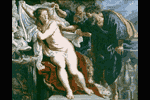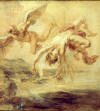|
Rubens, Peter Paul (1577-1640)
"The renowned Flemish master Peter Paul
Rubens drew together the main contributions of the masters of
the Renaissance (Michelangelo
and Titial) and of the Italian Baroque (Carracci and
Caravaggio) to
synthesize in his own style the first truly pan-European manner.
Rubens' art, even though it is the consequence of his wide study
of many masters, is no weak eclecticism but an original and
powerful synthesis. Ultimately the influence of Rubens was
international."
- Gardner's
Art Through The Ages,
11th edition, Vol. II, p. 747
|

"Rubens retained the vigor and
passion of his early style throughout his career, although
he modified the vitality of his work into less strained and
more subtle forms, depending on the theme. One theme
that remained a focus of Rubens' art was the human body,
draped or undraped, male or female, and freely acting or
free to act in an environment of physical forces and other
interacting bodies. This interest, combined with his
voracious intellect, led Rubens to copy the works of
classical antiquity and of the Italian masters.
- Gardner's
Art Through The Ages,
11th edition, Vol. II, p. 748

Susana and the Elders

The Fall of Icarus

The Rape of Europa

Studies of a Negro Head

The Judgement of Paris
|
|
|
|